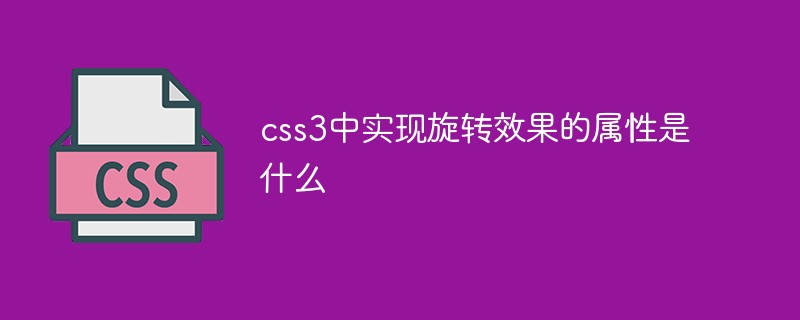
L'attribut qui permet d'obtenir un effet de rotation en CSS3 est "transform". L'attribut transform est utilisé pour appliquer une transformation 2D ou 3D à un élément. La rotation peut être obtenue lorsque cet attribut est utilisé avec les fonctions rotate(), rotate3d(), rotateX(), rotateY() ou rotateZ().

L'environnement d'exploitation de ce tutoriel : système Windows7, version CSS3&&HTML5, ordinateur Dell G3.
L'attribut qui permet d'obtenir un effet de rotation en CSS3 est "transform". L'attribut
transform est utilisé pour appliquer une transformation 2D ou 3D aux éléments. Lorsque cet attribut est utilisé avec la fonction suivante, la rotation de l'élément peut être réalisée :
rotate(angle) Définit la rotation 2D, en spécifiant l'angle dans le champ. paramètres.
rotate3d(x,y,z,angle) définit la rotation 3D.
rotateX(angle) Définit une rotation 3D le long de l'axe X.
rotateY(angle) Définit la rotation 3D le long de l'axe Y.
rotateZ(angle) Définit la rotation 3D le long de l'axe Z.
Exemple 1 :
<!DOCTYPE html>
<html>
<head>
<meta charset="utf-8">
<style>
div
{
width:200px;
height:100px;
background-color:yellow;
/* Rotate div */
transform:rotate(7deg);
-ms-transform:rotate(7deg); /* IE 9 */
-webkit-transform:rotate(7deg); /* Safari and Chrome */
}
</style>
</head>
<body>
<div>Hello</div>
</body>
</html>
Exemple 2 :
<!DOCTYPE html>
<html>
<head>
<meta charset="utf-8">
<style>
*,
*:after,
*:before {
box-sizing: border-box;
}
body {
background: #F5F3F4;
margin: 0;
padding: 10px;
font-family: 'Open Sans', sans-serif;
text-align: center;
}
h1 {
color: #4c4c4c;
font-weight: 600;
border-bottom: 1px solid #ccc;
}
h2,
h4 {
font-weight: 400;
color: #4d4d4d;
}
.card {
display: inline-block;
margin: 10px;
background: #fff;
padding: 15px;
min-width: 200px;
box-shadow: 0 3px 5px #ddd;
color: #555;
}
.card .box {
width: 100px;
height: 100px;
margin: auto;
background: #ddd;
cursor: pointer;
box-shadow: 0 0 5px #ccc inset;
}
.card .box .fill {
width: 100px;
height: 100px;
position: relative;
background: #03A9F4;
opacity: .5;
box-shadow: 0 0 5px #ccc;
-webkit-transition: 0.3s;
transition: 0.3s;
}
.card p {
margin: 25px 0 0;
}
.rotate:hover .fill {
-webkit-transform: rotate(45deg);
transform: rotate(45deg);
}
.rotateX:hover .fill {
-webkit-transform: rotateX(45deg);
transform: rotateX(45deg);
}
.rotateY:hover .fill {
-webkit-transform: rotateY(45deg);
transform: rotateY(45deg);
}
.rotateZ:hover .fill {
-webkit-transform: rotate(45deg);
transform: rotate(45deg);
}
.scale:hover .fill {
-webkit-transform: scale(2, 2);
transform: scale(2, 2);
}
.scaleX:hover .fill {
-webkit-transform: scaleX(2);
transform: scaleX(2);
}
.scaleY:hover .fill {
-webkit-transform: scaleY(2);
transform: scaleY(2);
}
</style>
</head>
<body>
<h1>CSS3 元素旋转</h1>
<!-- Rotate-->
<div class="card">
<div class="box rotate">
<div class="fill"></div>
</div>
<p>rotate(45deg) </p>
</div>
<div class="card">
<div class="box rotateX">
<div class="fill"></div>
</div>
<p>rotateX(45deg)</p>
</div>
<div class="card">
<div class="box rotateY">
<div class="fill"></div>
</div>
<p>rotateY(45deg)</p>
</div>
<div class="card">
<div class="box rotateZ">
<div class="fill"></div>
</div>
<p>rotateZ(45deg) </p>
</div>
</body>
</html>
(Partage vidéo d'apprentissage : tutoriel vidéo CSS)
Ce qui précède est le contenu détaillé de. pour plus d'informations, suivez d'autres articles connexes sur le site Web de PHP en chinois!
 tutoriel CSS3
tutoriel CSS3
 Quelles sont les propriétés du dégradé CSS3 ?
Quelles sont les propriétés du dégradé CSS3 ?
 Dernier classement des échanges de devises numériques
Dernier classement des échanges de devises numériques
 git annuler le commit soumis
git annuler le commit soumis
 Une fois l'ordinateur allumé, le moniteur n'affiche aucun signal
Une fois l'ordinateur allumé, le moniteur n'affiche aucun signal
 Qu'est-ce qu'un serveur de noms de domaine racine
Qu'est-ce qu'un serveur de noms de domaine racine
 Quelle est la température normale d'un ordinateur portable ?
Quelle est la température normale d'un ordinateur portable ?
 Quel logiciel utilisez-vous pour ouvrir les fichiers DAT ?
Quel logiciel utilisez-vous pour ouvrir les fichiers DAT ?